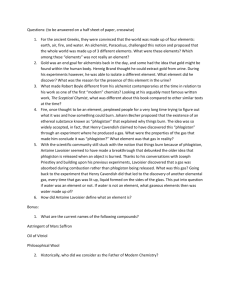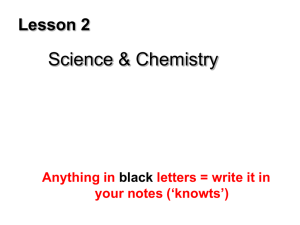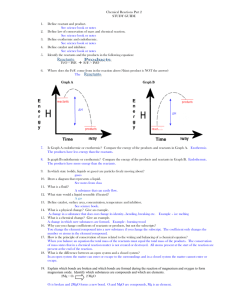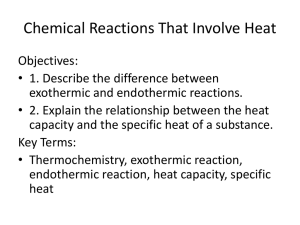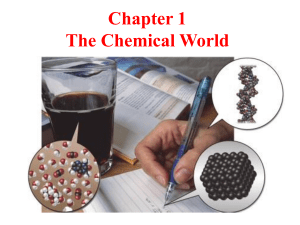Chapter 11 - Bakersfield College
advertisement
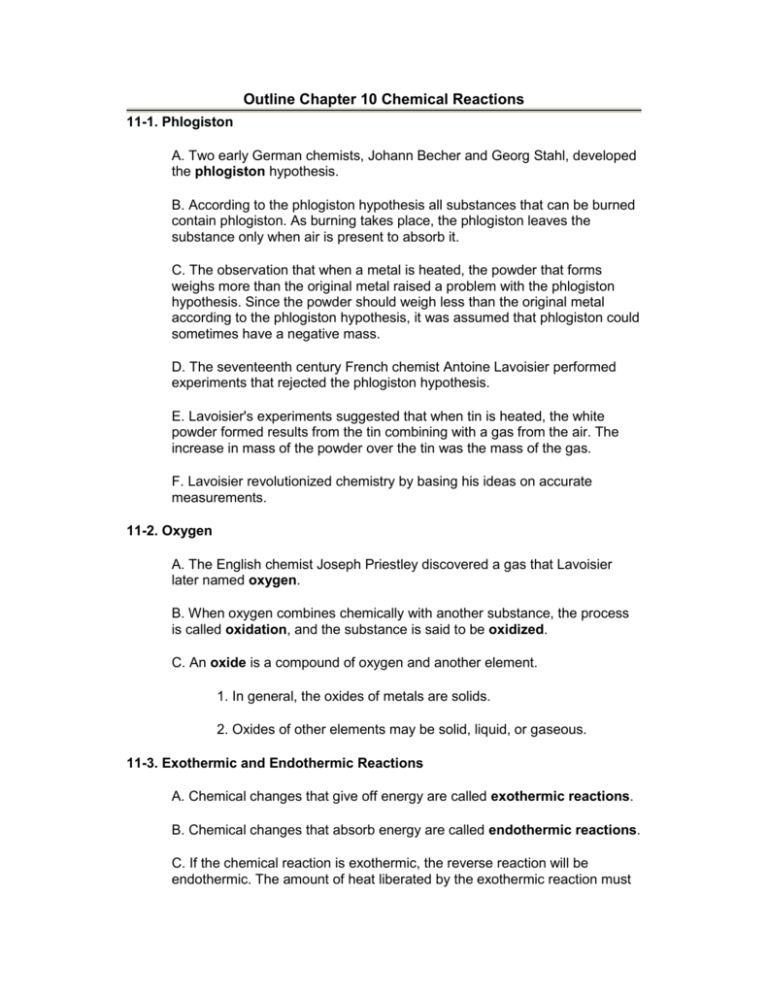
Outline Chapter 10 Chemical Reactions 11-1. Phlogiston A. Two early German chemists, Johann Becher and Georg Stahl, developed the phlogiston hypothesis. B. According to the phlogiston hypothesis all substances that can be burned contain phlogiston. As burning takes place, the phlogiston leaves the substance only when air is present to absorb it. C. The observation that when a metal is heated, the powder that forms weighs more than the original metal raised a problem with the phlogiston hypothesis. Since the powder should weigh less than the original metal according to the phlogiston hypothesis, it was assumed that phlogiston could sometimes have a negative mass. D. The seventeenth century French chemist Antoine Lavoisier performed experiments that rejected the phlogiston hypothesis. E. Lavoisier's experiments suggested that when tin is heated, the white powder formed results from the tin combining with a gas from the air. The increase in mass of the powder over the tin was the mass of the gas. F. Lavoisier revolutionized chemistry by basing his ideas on accurate measurements. 11-2. Oxygen A. The English chemist Joseph Priestley discovered a gas that Lavoisier later named oxygen. B. When oxygen combines chemically with another substance, the process is called oxidation, and the substance is said to be oxidized. C. An oxide is a compound of oxygen and another element. 1. In general, the oxides of metals are solids. 2. Oxides of other elements may be solid, liquid, or gaseous. 11-3. Exothermic and Endothermic Reactions A. Chemical changes that give off energy are called exothermic reactions. B. Chemical changes that absorb energy are called endothermic reactions. C. If the chemical reaction is exothermic, the reverse reaction will be endothermic. The amount of heat liberated by the exothermic reaction must be the same as the amount of heat absorbed by the endothermic reaction. D. Dissociation is an endothermic process. E. Neutralization is an exothermic process. 11-4. Chemical Energy and Stability A. The more energy needed to decompose a substance, the greater the chemical stability of the substance (with a few exceptions). B. Chemical energy is electron potential energy. C. When electrons move to new locations during an exothermic reaction, some of their original potential energy is liberated. 1. The freed energy may show itself in faster atomic or molecular motions that correspond to a higher temperature. 2. The freed energy may excite outer electrons into higher energy levels from which they return by releasing photons of light. D. In endothermic reactions, energy must be supplied to the atoms involved to enable some of their electrons to form bonds in which their potential energies are greater than before. 11-5. Activation Energy A. In many exothermic reactions, the reactants must be activated, or supplied with sufficient outside energy to make the reaction start. B. The energy needed to start a reaction is called the activation energy. C. A molecule having enough energy to react is called an activated molecule. 11-6. Liquid Fuels A. Petroleum, a mixture of various hydrocarbons, is the source of most liquid fuels. B. The products of the incomplete combustion of gasoline, which can occur even under the best circumstances, may include carbon monoxide, unburned hydrocarbons, and nitrogen oxides, all of which are harmful. C. The lead compound tetraethyl lead was added to gasoline to prevent engine "knocking" and resulted in the emissions of poisonous lead compounds. D. There are three ways to reduce the amounts of pollutants in vehicle exhausts: 1. Build an engine that completely burns a mixture of lead-free gasoline and air at the right temperature to minimize theemission of carbon monoxide, unburned hydrocarbons, and nitrogen oxides. Such an engine is difficult to produce. 2. Use a catalytic converter to convert the polluting exhaust gases of burned lead-free gasoline into harmless gases. 3. The use of "reformulated gasoline" which can reduce toxic emissions by 10 to 15 percent.. 11-7. Gas Fuels A. Natural gas is largely methane, CH4. B. An artificial gas fuel called syngas is produced by passing very hot steam over coal. C. Underground coal can be gasified. Incomplete combustion of the coal will produce carbon monoxide, which can be used as a fuel or reacted with steam to give hydrogen. D. Hydrogen gas is an excellent fuel produced by the electrolysis of water. 11-8. Solid Fuels A. Types of solid fuels include coal, wood, and coke. B. There are three varieties of coal: 1. Bituminous (soft) coal, the most common variety 2. Anthracite (hard) coal 3. Lignite C. All varieties of coal, and furnace oil derived from petroleum, contain sulfur, which plays a major role in the ecological problem of acid rain. D. Upon combustion of these fuels, sulfur is oxidized to sulfur dioxide, SO2. Nitrogen from the air is also oxidized to produce nitrogen oxides. These substances combine with atmospheric moisture to produce sulfuric acid and nitric acid, respectively. E. The presence of these acids in the atmosphere has increased the average acidity of rainwater in much of Canada, the United States, and Europe. F. The effects of acid rain include 1. The dissolution and loss of plant nutrients from the soil. 2. The conversion of nontoxic aluminum compounds in the soil to toxic compounds. 3. The release of toxic metals into drinking water supplies. G. One method of reducing acid rain is to "scrub" exhaust gases emitted by coal-fired power plants and metal refineries by mixing the gases with a lime (CaCO3) solution. 1. The sulfur dioxide in the exhaust gases combines with the lime to produce solid calcium sulfate. 2. The resulting calcium sulfate sludge presents a disposal problem because of the vast amount produced. 11-9. Temperature A. Reaction rates are increased by a rise in temperature. B. A 10âC rise in temperature approximately doubles the speed of a chemical reaction occurring at or near room temperature. C. Reaction rates increase with temperature primarily because the number of activated molecules increases. D. Ionic reactions are very fast even at room temperatures because the ionic state itself is a form of activation. 11-10. Concentration and Surface Area A. Reaction rates of simple chemical reactions are proportional to the concentrations of the reactants. B. Reaction speed depends on the amount of the solid surface exposed; the greater the surface area, the faster the reaction. 11-11. Catalysts A. A catalyst is a substance that can change the rate of a chemical reaction without itself being permanently changed. B. Catalysts accelerate reactions in different ways: 1. The catalyst forms an unstable intermediate compound with one of the reactants which decomposes later in the reaction. 2. The catalyst increases the reaction rate by producing activated molecules at its surface. C. An enzyme is a protein catalyst that accelerates a specific chemical reaction within a living organism. 11-12. Chemical Equilibrium A. Most chemical reactions are reversible. B. In a chemical equilibrium, forward and reverse reactions occur at the same rate; the concentration of the reactants and products remain constant. C. Many chemical reactions reach an intermediate equilibrium state instead of going to completion. 11-13. Altering an Equilibrium A. In a chemical reaction that reaches equilibrium instead of going to completion, equilibrium conditions must be altered to increase the yield of a desired product. B. There are three methods for adjusting a chemical equilibrium in one direction or the other: 1. Change the concentration of one or more substances. 2. Change the temperature. 3. Change the pressure. 11-14. Electrolysis A. Chemical reactions that involve electron transfer are called oxidationreduction reactions. B. Oxidation involves the loss of electrons by the atoms of the element in a chemical reaction; reduction involves the gain of electrons. C. Electrolysis, in which free elements are liberated from a liquid by the passage of an electric current, is an example of an oxidation-reduction reaction. D. In electrolysis, an electrode is a conductor through which electric current enters or leaves a solution. E. Electrolysis is used in the process of electroplating, in which a thin layer of one metal is deposited on another metal. 11-15. Electrochemical Cells A. Oxidation-reduction reactions can produce electric currents by having the transferred electrons pass through an external conductor as they go from one reactant to another. B. Electrochemical cells use oxidation-reduction reactions to produce electric current. C. Examples of electrochemical cells include dry-cell batteries, lead-acid storage batteries, and fuel cells. D. Unlike dry-cell and lead-acid storage batteries, fuel cells can provide electric current indefinitely without having to be replaced or recharged, because the reactants are fed continuously.

